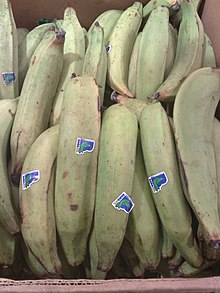ငှက်ပျော
Jump to navigation
Jump to search
Burmese
[edit]
Etymology
[edit]The first syllable, ငှက် (hngak), is from Proto-Tibeto-Burman *s-ŋak (“plantain, banana”), and cognate with the first syllable of Akha [script needed] (ŋa djɛq, “wild banana”) (STEDT). The second syllable, ပျော (pyau:), is of unclear origin and interpretation.[1]
Pronunciation
[edit]- Phonetic respelling: င'ပျော
- IPA(key): /ŋəpjɔ́/
- Romanization: MLCTS: hngakpyau: • ALA-LC: ṅhakʻpyo • BGN/PCGN: ngăpyaw: • Okell: ngăpyò
Noun
[edit]ငှက်ပျော • (hngakpyau:) (classifier ဖီး)
Usage notes
[edit]As with most fruit names, this word is usually found compounded with သီး (si:, “fruit”); the full term is thus ငှက်ပျောသီး.
Derived terms
[edit]- ငှက်ပျောပပ် (hngakpyau:pap)
- ငှက်ပျောပွဲ (hngakpyau:pwai:)
- ငှက်ပျောပွဲအုန်းပွဲ (hngakpyau:pwai:un:pwai:)
- ငှက်ပျောပေါင်း (hngakpyau:paung:)
- ငှက်ပျောဖူး (hngakpyau:hpu:)
- ငှက်ပျောသီး (hngakpyau:si:)
- ငှက်ပျောအူ (hngakpyau:u)
- ရွှေငှက်ပျော (hrwehngakpyau:)
- သီးမွှေးငှက်ပျော (si:hmwe:hngakpyau:)
- သူငယ်စာငှက်ပျော (su-ngaicahngakpyau:)
- အုန်းငှက်ပျော (un:hngakpyau:)
References
[edit]- ^ Luce, G. H. (1981) “-AW Finals (25. Banana, Musa sapientum)”, in A Comparative Word-List of Old Burmese, Chinese and Tibetan, London: School of Oriental and African Studies, University of London, →ISBN, page 25
Further reading
[edit]- “ငှက်ပျော” in Myanmar–English Dictionary (Myanmar Language Commission 1993). Searchable online at SEAlang.net.